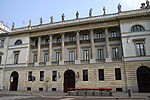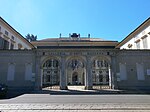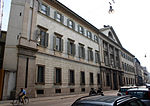Palazzo Castiglioni (Milan)
1903 establishments in ItalyArt Nouveau architecture in MilanArt Nouveau housesHouses completed in 1903Palaces in Milan ... and 1 more
Tourist attractions in Milan

Palazzo Castiglioni is an Art Nouveau palace of Milan, northern Italy. It was designed by Giuseppe Sommaruga in the Liberty style and built between 1901 and 1903. The rusticated blocks of the basement imitate a natural rocky shape, while the rest of the decorations are inspired by 18th century stuccos. The building is now used as the seat of the Unione Commercianti di Milano (Traders' Union of Milan).
Excerpt from the Wikipedia article Palazzo Castiglioni (Milan) (License: CC BY-SA 3.0, Authors, Images).Palazzo Castiglioni (Milan)
Corso Venezia, Milan Municipio 1
Geographical coordinates (GPS) Address External links Nearby Places Show on map
Geographical coordinates (GPS)
| Latitude | Longitude |
|---|---|
| N 45.471108333333 ° | E 9.2013444444444 ° |
Address
Palazzo Castiglioni
Corso Venezia 47
20121 Milan, Municipio 1
Lombardy, Italy
Open on Google Maps










